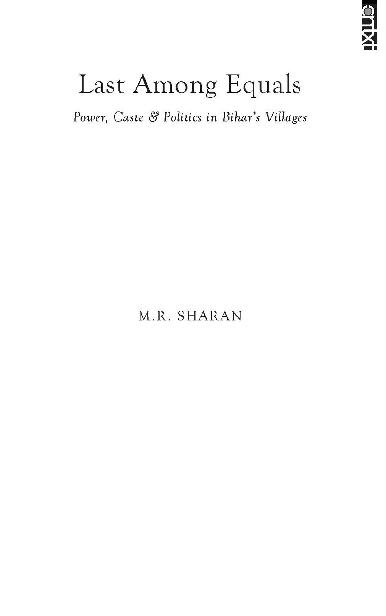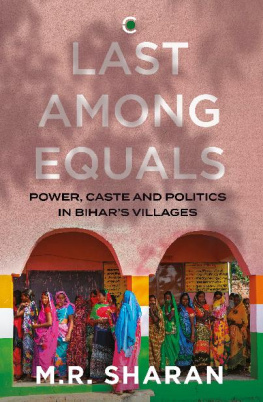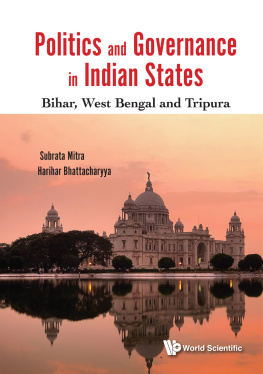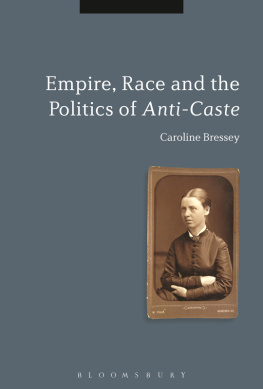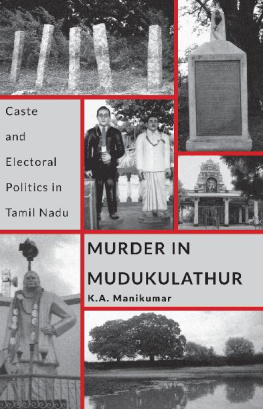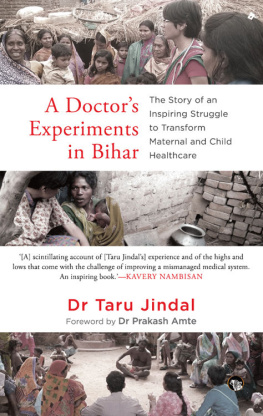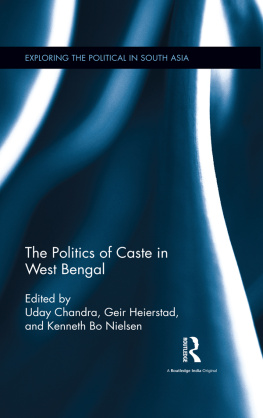First published by Context, an imprint of Westland Publications Private Limited, in 2021
1st Floor, A Block, East Wing, Plot No. 40, SP Infocity, Dr MGR Salai, Perungudi, Kandanchavadi, Chennai 600096
Westland, the Westland logo, Context and the Context logo are trademarks of Westland Publications Private Limited, or its affiliates.
Copyright M.R. Sharan, 2021
ISBN: 9789390679669
The views and opinions expressed in this work are the authors own and the facts are as reported by him, and the publisher is in no way liable for the same.
All rights reserved
No part of this book may be reproduced, or stored in a retrieval system, or transmitted in any form or by any means, electronic, mechanical, photocopying, recording, or otherwise, without express written permission of the publisher.
W hen Mahatma Gandhi stated that India lived in its villages, he was reminding his audience, college-going elite youth, that most of India did not live like them. Biharhome to one in ten Indians, most of them deeply politicalstill largely lives in its villages. In 1917, Gandhi led the peasants and farmers of Champaran on the first Satyagraha against the colonial government in India. Nearly a hundred years later, in a village a hundred kilometres from Champaran, a group of workersmazdoorsorganised a peaceful protest meeting of their own against their local government. With the monsoons receding and sowing done, the mazdoors wanted work. They turned to their local officials, applying for work under the National Rural Employment Guarantee Act (NREGA). The NREGA is an India-wide rural work-on-demand scheme: mazdoors are to be provided work in their villages within fifteen days of applying.
With over a month having passed and no response, the mazdoors had called for a meeting and, in the spirit of Gandhian deliberation, also invited local government officials to participate. At the appointed hour, workers, many of whom were women, from different villages, all affiliated with a workers group called the Bihar Manrega Watch (BMW) showed up at the venue, a patch of unclaimed land by some fields. Meetings like this usually follow a familiar pattern: first, theres some call-and-response sloganeering. Arms aloft, fists clenched, somebody would, for instance, shout Ladenge! (We will fight!); this would then be followed by a roar, Jeetenge! (We will win!) Next, the workers sing songs of struggles, and sometimes make speeches, all interspersed with more sloganeering.
As the day wore on, it became evident that the bureaucrats who were invited would not show up. Somewhat unexpectedly, however, an uninvited representative of the local government did show up. This was the mukhiya, elected head of the village council, who was also the most powerful man in the village. He was known to be corrupt, a key reason he had not received an invitation to the meeting. On reaching the venue, he barely paused to take in the crowdthis protesting band of loud but peaceful mazdoorsand, with a few henchmen in tow, tore into them. As a participant at the meeting told me later, the mukhiya beat up the mazdoors with his bare hands.
This is a book about mukhiyas, but even more so about mazdoors. In village politics, the mukhiyas have been the insiders among insiders, often born into wealth and belonging to dominant castes, amassing power and influence. They run local government, allocate funds and profoundly shape the lives of the poor. The mazdoors are anonymous outsiders, on the margins of society: Dalits, women, backward castes, daily-wage labourers.
This book is also about a cast of characters who are neither insiders nor outsiders. Since independence, but even more so in the past few decades, there has been a slow chipping away at old feudal relations in villages. The distinctions between insiders and outsiders are neither clear nor static: some insiders are more on the inside than others; other insiders feel more like outsiders; many outsiders aspire to be, and sometimes become, insiders; and, just as in the case of insiders, there are tiers of outsiders.
The mukhiya and the mazdoor represent two ends of a spectrum in considerable flux.

Up until the age of twenty-three, I was a stranger to Bihar. I was brought up in Manipal, a small university town, and went to college in Delhi. Yet, in my first few months in Bihar, many mistook me for a local, because my first name, Sharan, was a not entirely uncommon surname. Saran-ji, Bihar main kahaan padta hai ghar aapka? (Where in Bihar are you from?) I would be asked, and I would have to explain that I was an outsider. In those initial days, Bihar had seemed bewildering and distant. Moreover, to the mazdoors of Muzaffarpur, whom I had met within a couple of months of living in Bihar, Karnataka was as foreign as Kiribati. Yet, over time, both Bihar and I grew more familiar with each other. One morning in 2017, as I was hurrying along the path to the BMW office in the village of Ratnauli, Somariya Devi, a mazdoor with long, braided grey hair and a mischievous twinkle, asked: Saran-ji, bhoj nahin khilaaye? (Saran-ji, will you not hold a feast for us?) How was it, she wondered, that I had got married in the past year and had not yet thrown her a celebration dinner?
I may have still been an outsider to Bihar, but in that moment, as I watched her smile and groped for a wisecrack response, it felt a little like home.
Since 2012, when I first lived in Bihar, there have been two broad reasons for my continued engagement with it. First, the research. I began as a research associate on a study that evaluated a computerised wage-payment system for rural wage workers under the NREGA. In the year 2009, the NREGA had been renamed MGNREGA, where M and G stood for Mahatma Gandhi. In the villages of Bihar, it used to be called Narega, but is now increasingly known as Manrega.
This was not my first brush with the NREGA or village governments: I had previously worked on another study in Andhra Pradesh that focused on the role of women leaders in villages and their impact on the implementation of the Act. However, the scope of the Bihar studyit was spread across thousands of villages in twelve districtsguaranteed that my fieldwork was intense and wide-ranging. I gained access to a kaleidoscopic range of actors, mostly insiders, meeting everyone from the casual wage labourer in the village to the rural development department secretary in the magisterial Old Secretariat building in Patna. I met panchayat heads and activists, block development officers (BDOs)the most powerful bureaucrat in a block, which is roughly fifteen panchayatsand old Left-party leaders, youth entrepreneurs and Patnas landed elite. This exposure expanded my research interests. Over the years, I graduated to working on topics beyond the NREGA, to focus on local politics, caste, reservations and transparency in government. My research is typical of any quantitatively trained economist, relying on datasets ranging from primary surveys to big administrative data.
The second, and more important, reason for my deep engagement with Bihar is the friends I made there. Several co-researchers have turned out to be people I have formed lasting links with, extending well beyond the scope of our professional friendship. However, the most unusual bond I forged was by happenstance, and unconnected to the world of my researchwith Sanjay Sahni and the peoples movement he founded in Muzaffarpur, of which BMW was a part. We came from entirely different worlds. Sanjay and I grew up in almost diametrically opposite parts of India (south-west vs north-east), spoke different tongues, were brought up to eat, behave and think differently. The economic gulf between us remains vast. Yet, we became fast friends, bound by affection, ideology, and my respect for him and the inspirational mazdoorsmostly womenwho have journeyed alongside him.

